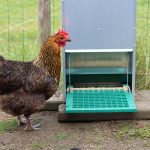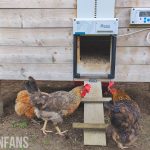Chicken Roosts: Sleep, Perches & Dimensions
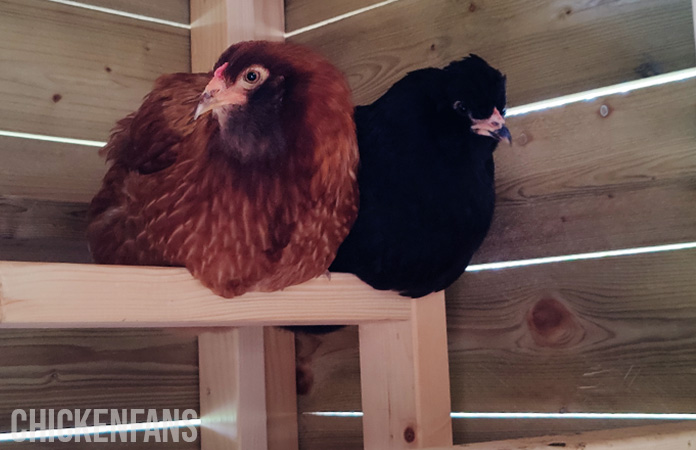
Chickens need a roosting place in the chicken coop to sleep and spend the night. They stand upright on perches while they sleep. It’s their instinct to sleep standing on branches in a tree, so that’s what we mimic in the chicken coop.
We’ll tackle everything you need to know:
- What is roosting and what is a roosting perch?
- Why do chickens roost?
- The roosting bar, dimensions and location
- Ladder type roosting bars vs Same Height
- What are appropriate materials for roosting perches?
- Roosting behavior and social interaction
But first things first:
What is Roosting and what is a Roosting Perch?
Roosting for birds is settling down for sleep after a day of flying around. The place where they roost is called the roosting place or in short: the roost. The perch is the actual branch or rod they sit on while sleeping.
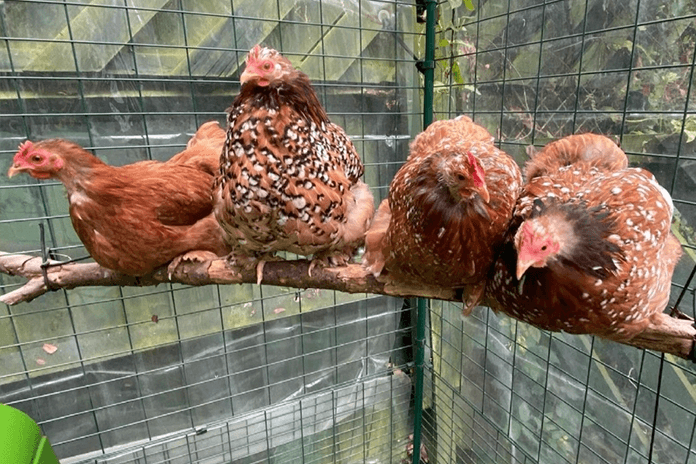
Chickens also sit on the perches during the day, but it’s only called roosting when they are sleeping at night.
Why do Chickens Roost?
It might come as a surprise, but birds never sleep in their nests.
They don’t. It’s a common misconception that they do.
We tend to imagine cute birds sleeping in a little nest, but they don’t. Birds that make nests only use the nest for eggs and raising their chicks. These nests become a total mess and attract parasites and predators over time, so when they no longer need them, they abandon the nest.
So where do chickens sleep?
Chickens sleep on branches above the ground, away from predators. This also prevents them from sitting in their own poop.
However, the ultimate safe place does not exist in the wild. So that’s why some of the chickens in the flock literally keep one eye open when they sleep. They have the remarkable ability to sleep with one half of their brain, so the other part can stay alert (this is called unihemispheric sleep).
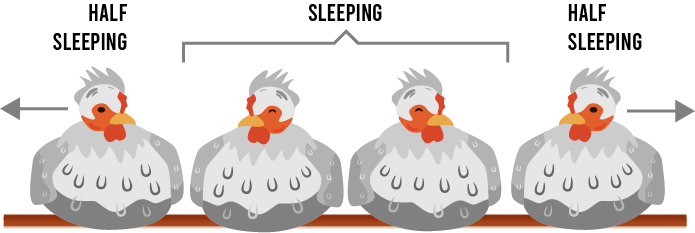
Do chickens roost automatically? Is it in their instinct to roost?
Chickens don’t necessarily always have the instinct to sleep on the perches. Some pullets prefer to sleep on the ground and can be very resistant to learning to roost. Chicks are routinely raised in very clean and safe brooder environments and they might not have the reflex to get away from the dirt.
This might not be a problem at all. There are no immediate health issues related to the lack of roosting. But hold on.
Do chickens have to roost?
Chickens produce a substantial amount of poop overnight. If you find them sleeping in their nighttime poop, their butts can become a total mess. Sometimes they even have poop on their back from birds that do use the perches and are sitting on top of them.
When they are sitting on the floor, they are in close contact with the coop bedding, harboring parasites and bacteria. If they are sleeping on the roosting perches, it’s much easier to use dropping boards for quick cleaning.
Roosting is also a social event. Scientists are still investigating the social relationship between roosting partners in a flock. It’s unclear if sleeping on the floor has an impact on their social life and stress levels.
The Roosting Bar
You might think any branch is good for a chicken to sit on, but there are some important things to be aware of.
Chickens are special birds
Birds like parrots can put a death grip on the perches to hang upside down and eat. Can you imagine a hen swinging on the ceiling of her chicken run?
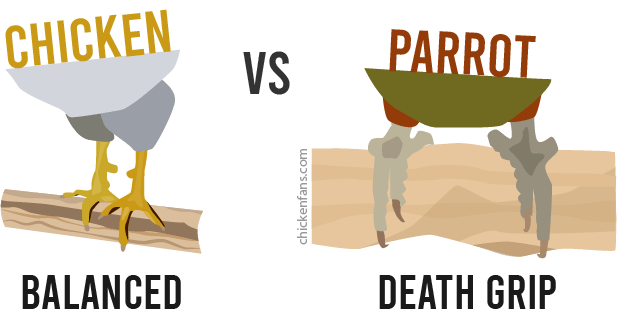
Chickens don’t grip the perch but sleep with their feet flat, balancing on their sticky legs. They will naturally curl their toes around the roosting bar, but the toes won’t clamp tightly around the perch.
Size and Dimensions
What size should a chicken roosting bar be?
For the roosting bar, you can go for a branch, a round wooden dowel, or a wooden beam. In general, if you can see their toes, the roost isn’t wide enough. They need to cover their toes with feathers while roosting to keep the cold out.
For a branch or wooden dowel (poles), look for a thickness in the range of 1.5 – 2.5 inches. For dowels longer than 6 ft, foresee at minimum 2 inches and extra support. Chickens aren’t too heavy but the bar needs some stiffness.
A popular option is to use 2x4inch wooden beams, sanded to remove the sharp edges. Put them with the wide side up, so the chickens can put their feet flat, but still curl their toes around the beam.
Do smaller chickens need smaller perches?
Smaller chickens and Bantams don’t really need smaller perches. With mixed flocks, create your perches for the larger chickens and the smaller ones will happily join them.
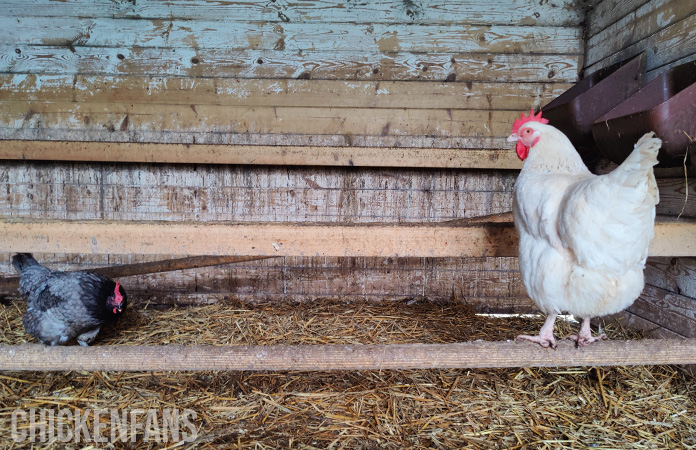
How High should a chicken roosting bar be?
The roosting perches should be at least 1,5 to 3 feet above the ground. Chickens usually prefer to roost as high as possible. Just make sure they can reach the perches. If the roosting places are high, you can make a ladder so the larger chickens can get up.
They also need to get on the bar without bumping their head. Leave 18 to 24 inches of headspace between the perch and the ceiling.
It’s important to have the perches higher than their nesting boxes. If not, they will start to roost in their nesting boxes.
You don’t want them to sleep in their nesting boxes. Not only will they sleep in their poop and mess up their feathers, but the nesting material will also get dirty and full of bacteria. They also risk breaking their eggs and eating them.
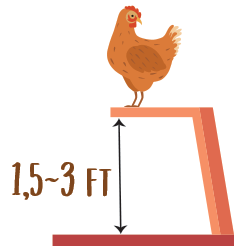
How Long should a chicken roosting bar be?
The roosting bar should provide enough space for the hens to sit next to each other when roosting.

Each hen needs about 8 to 10 inches of space to roost comfortably.
If you have bars longer than 6ft, go for a diameter that is a minimum of 2 inches and add support in the middle.
Roosting Bars: same height vs ladder structure
If you have a ladder perch with roosting bars on different heights, all the chickens will try to get to the top rungs. The pecking order is a real thing here. Hens at the lowest place in the pecking order will end up on the lowest branches. If the bars are placed one above another, they can poop on each other too.
This can all be avoided by placing the roosts at the same level. When placed at the same level, keep 12 to 16 inches of space in between, so they can settle comfortably.
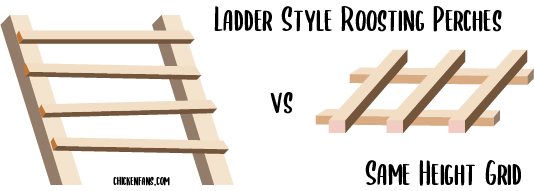
Placing the handles at the same height will also make it easier to place the dropping boards.
Placement of the Roosting Perch
Roosting perches should be inside of the chicken coop. The roosting places should be at a distance from the nesting boxes and should be placed higher than the nesting boxes. If not, there is the risk that they will start sleeping in their nesting boxes. This is not recommended, as they can break and eat their own eggs and they are messing up the nesting material.
Apart from the nesting box, keep the perches apart from the place where they get their water and food, to prevent contamination.
Roosting Perch materials & mounting
The best material for perches is wood. It’s durable and it’s what they are sitting on in nature.
These are the possible perching materials:
- wood – durable and sturdy. Any type of wood will do, but make sure it’s non-treated and free from splinters. When you are using 2×4’s, make sure to sand the edges or mill the corners.
- branches – the natural perch is also a great choice, but make sure it’s strong enough, has the right diameter, and doesn’t come with mold
- metal – metal is not ideal. It is durable, but in the winter, it gets too cold and when it’s freezing their feet can freeze on the bar. It can also be slippery.
- plastic – you will encounter a lot of plastic if you are looking at the shelves in the store. It’s cheap, but it’s slippery and also not very sturdy. Chickens don’t weigh too much, but they are no quails either. They will also not always gently strike on the bar, especially when they are fighting for the highest one and flapping around.
- bamboo poles – an option when it’s not too slippery. It’s usually not big enough, so make sure it is at minimum two inches wide. If not, the toes of the chickens will stick out and when it freezes they risk frostbite. You might consider binding some together or use bamboo only for daytime roosting.
Since wood is a good choice, the follow-up question is usually
Can I paint the Roosting Bar?
Yes, you can paint the roosting bar. But it’s a matter of preference.
Some people paint the roost so it becomes easier to clean and is resistant to parasites, such as red mites. Depending on the situation, the paint can get scratched off and the chickens will pick up whatever is flying around. So if you paint, we recommend non-toxic paint. Some glossy exterior paint can aid in cleaning.
An alternative to painting is to oil the wood. The oil soaks into the wood and dries, thereby creating a waterproof barrier. It also prevents any mites that would want to house on the perches. Tung oil and linseed oil are plant-based, non-toxic oils that are perfect for the job.
Roosting Behavior
At what age do chickens start to roost?
Chicks will start to sit and play on the perches from 4 weeks old.
However, they will only start sleeping on them when they are about 7 or 8 weeks old.
Why won’t my chickens roost at night?
Chickens don’t always use the perches instinctively. You might find them sleeping on the ground or in their nesting boxes.
This happens frequently with chicks coming from the brooder where they did not learn to roost. It can also happen when you introduce new chickens to the flock. They don’t know the pecking order yet and tend to sleep in weird places until they are aware of the social relationships within the chicken coop.
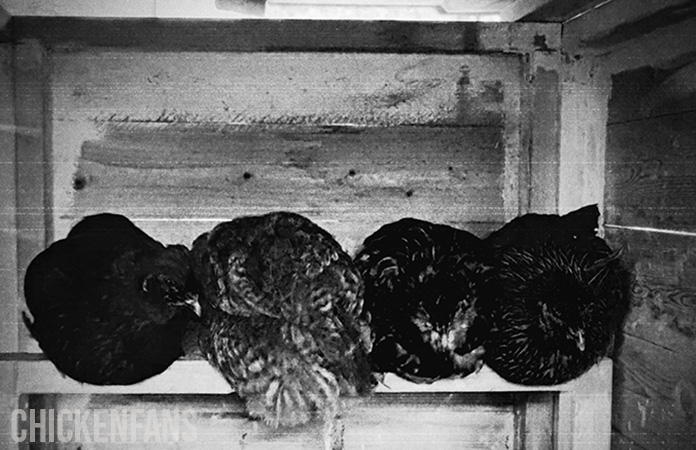
Other common reasons why chickens won’t roost are:
- age – some hens start to roost only at a later age
- ventilation and temperature – it might be too hot or cold at the roosting bar when you see them flocking in the corner
- problems with the roosting perches – the perches may be too close to the wall, not mounted well enough, etc.
- not enough space – make sure all hens have some space where they can rest
- going to bed too early – when the coop is closed before sunset, they might want to hop around a little longer before going to roost
- broody hen – hens can go broody and will stay in their nests
If your chickens are not going back to the coop to roost, there might be some other issues:
- parasites – especially red mites will prevent your chickens to go back to the coop
- predators – if the coop had a visit of a predator, the chickens can be scared to go back in the coop
- dirty coop – a dirty coop will have walms of ammonia, hens will refuse to return to such unhealthy conditions
If none of these conditions apply, you will need to learn your chickens how to roost.
How do you learn chickens to sleep on the roost?
If they are not roosting, make sure they are sleeping in optimal conditions:
- temperature and ventilation are okay
- the perches are solid, well placed and there is enough space
- the hens are not broody, the coop is clean and there are not parasites
When they are sleeping in their nesting boxes, cover the nesting boxes, so they can’t get in at night.
The next thing is to learn them some new habits:
- get them inside the coop before sunset, to prevent them from roosting in the trees
- place one or two hens on a root, to show the younger ones how they should sleep
- repeat until they start to roost
This can take some time.
Some learn it in a couple of days, some take two weeks. But they will learn it eventually.

